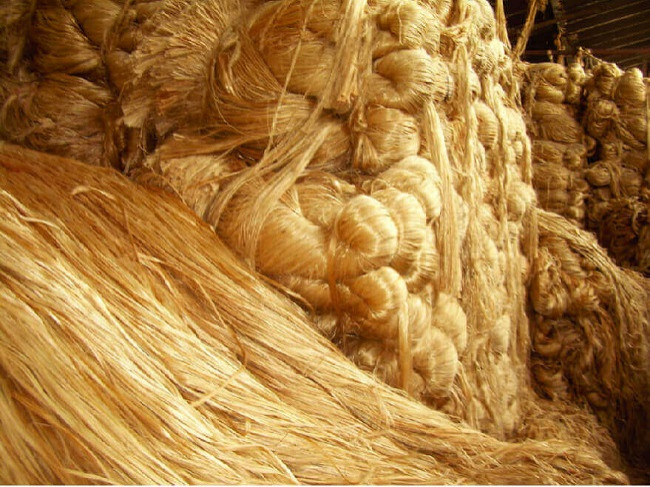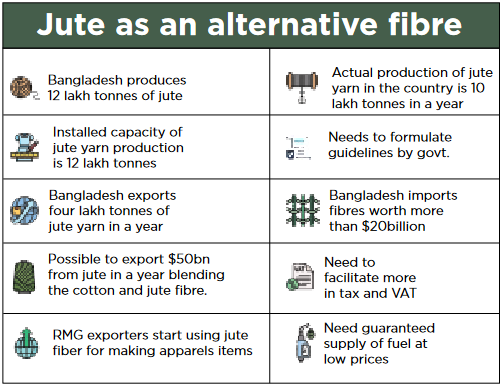Perhaps, the jute is going to get back its lost glory as the demand for jute may increase in manifold if the local garment exporters start using the jute fibre as an alternative to imported cotton and non-cotton fibre for making the apparels items.

The government, jute millers, jute spinners and the garment exporters have been working on how to increase the use of jute fibre for making the garment items so the diversification of garment fibre is increased.
Currently, on an average, Bangladesh imports fibres or raw materials like knit and woven fabrics, yarn and cotton worth more than $20billion to feed the local export oriented garment factories and for local markets to some extent.
If the jute fibre can be used in making the garment items as a diversified fibre, the country can save the significant portion of this $20 billion in a year for which we will not need to rely on imported fabrics, yarn and cotton for making the garment items for export purposes.
What the jute fibre producers say
Md. Saiful Islam, Managing Director of Faridpur based Mazeda Jute Industries Ltd, is one of such jute fibre maker and exporters.
It is possible to bring a revolution in jute industry if the jute fibre can be used in making garment fibre, Islam said adding currently he along with other spinners are making jute fibre and yarn to export to other countries.
Annually, Bangladesh produces 12 lakh tonnes of jute and the installed capacity of jute yarn production is 12 lakh tonnes and actual production of jute yarn in the country is 10 lakh tonnes in a year.
Bangladesh exports four lakh tonnes of jute yarn in a year, mainly for making the jute carpets, he said adding it is possible to export $50 billion from jute in a year if the garment fibre is made blending the cotton and jute fibre. That means the jute fibre can be used for more value addition, he said.
For instance the viscose fibre is made with the blending of fibres and if the fibre is made from the jute and cotton it would be wonderful fibre.

Bangladesh will have to go for such blended fibre in a massive scale in future if it wants to be more competitive worldwide in garment trade, he added.
The government needs to formulate guidelines and needs to facilitate more in tax and VAT so the jute fibre can be produced in mass scale and contribute to the garment export of the country. He said he has been producing such fibre to some extent for export purposes.
The production capacity in his factory is 30 tonnes a day and currently he can produce 15 tonnes daily because of different problems like higher cost of fuel oil and electricity. He mainly produces yarn, jute bags and textile fibres and export 90 percent of the produced goods.
In Bangladesh, the number of jute mills is more than 350 and of this number 83 are jute spinners, he added.
Islam, who is also a former board of director of the Bangladesh Jute Spinners Association (BSJA) wants the government’s guideline for making the best use of jute fibre for bringing back the lost glory of jute.
Abul Hussain Mia, Chairman of Bangladesh Jute Mills Association said the future of textile fibre is jute fibre as the fibre diversification is taking place in the country.

He also said the government, jute millers, garment exporters and textile millers are working together on how to improve the use of jute as textile fibre so the country needs not to import the fabrics with spending billions of US dollars.
The use of jute fibre is garment is also increasing because the western countries are reducing the use of Chinese, Uzbekistan and some other central Asian cotton for different reasons.
Primarily, they are planning for production of 50 -50 blending of jute and cotton fibre and if they are successful the 100 percent jute fibre may be produced in future, Mia also said.
The current fibre situation in garment production
Bangladesh is probably the number one cotton fibre made garment exporter worldwide as many countries, particularly China is reducing over dependence on shipment of cotton based garment items to make a very good business with receiving better prices by selling non-cotton based garment export from the international clothing retailers and brands.
Currently, of the total garment export from Bangladesh some 74 percent is made of from the cotton fibre and remaining 24 percent is made from the non-cotton fibre.
However, the global scenario is just opposite. Globally, of the total fashion industry 78 percent is made from the non-cotton fibre and 22 percent is made from the cotton fibre.
The prices of the non-cotton fibre garment items are also higher than the cotton fibre made garment items because of product sustainability, quality and better functionality.
For instance, if a T shirt made from cotton fibre it is sold at $5 per piece but if it is made from non cotton fibre the price of the same T shirt is more than $10 per piece because of better quality, longevity and functionality.
Since Bangladesh is very strong in cotton based fibre garment items, it has been striving to diversify its fibre over the last many years. Recently, some textile factories have invested money in recycled yarn making, particularly from the left out plastic bottles and left out garment scrape, which is popularly known as jhoot fibre. However the availability of these fibre is still difficult in Bangladesh as the country has limited resources.
Currently, Bangladesh meets its cotton demand through import for its almost entire requirement. Because Bangladesh produces less than two percent of the required cotton and more than 98 percent is imported. So from the very beginning historically Bangladesh is very strong in cotton fibre garment making. As a result the fibre diversification did not take place in larger scale here in the country. But the world situation deserves fibre diversification.
Why fibre diversification is required
Fibre diversification is a demand for the time as there is a possibility of losing competitiveness in the global fashion business. Because with the changing landscape of global fashion the prices of non-cotton garment items are almost double of those made from the cotton based fibre. Bangladesh is very strong in basic garment and receive lower prices from the international clothing retailers and brands. If the local garment exporters want to be more competitive in global fashion business they must go for diversified fibre like recycled yarn and non-cotton fibre garment items.
The international clothing retailers and brands are saying that they will not buy garment items if those are not made from the man-made fibre or recycled yarn as they want to save the environment with making the garment from non-cotton fibres. Only with making garment from the cotton fibre cannot make the local apparel suppliers competitive in the near future when the country will graduate to a developing nation from the list of least developed countries (LDCs) in 2026.
So fibre diversification is very important for Bangladesh. Also because the demand for non-cotton items is falling worldwide and the prices as well but the cost of production is increasing. The diversified garment items are also necessary for the diversified markets. For instance, the demand garment items in the Asian markets, particularly in the Middle Eastern nations does not match with the demand in the western countries like in the Europe and USA.
What BGMEA leader says
Faruque Hassan, president of Bangladesh Garment Manufacturers and Exporters Association (BGMEA) at an event on sustainability report launching of a group of garment at a city hotel Friday said they have been working on fibre diversification to reduce over dependence on the cotton fibre.
The BGMEA has been working with the government for developing the jute fibre to diversify its types. He said he held a meeting with the foreign ministry Friday to diversify the jute fibre and to make garment items from jute.
BGMEA has already teamed up with many retailers and brands along with the local spinners and weavers for diversifying the fibres like producing yarn from recycled fabrics, petroleum products and buckles of different trees to diversify the fibre.
The Swedish retail giant H&M also recently said it has a big plan for sourcing for Bangladesh although the price will increase by up to 12 per cent following the country’s graduation from the grouping of the least-developed countries in 2026.
After becoming a developing nation, Bangladesh will lose its preferential market access and face 10 to 12 per cent duty on its exports. However, it will enjoy the duty preference in the European Union up to 2029 as the trade bloc has extended a three-year grace period, according to a media report.
The H&M suggested Bangladesh improve product diversity as more than 75 per cent of exported garment items are confined to the top five products although the country is the second-largest apparel supplier in the world.
Globally, the use of artificial fibre is rising.
MMF apparel items accounted for $222 billion of the $440 billion global garments market last year when cotton-based products contributed $190 billion.
Apparel exports from Bangladesh will cross $95 billion by 2030 if the country can expand its share in the global market for MMF to 12 per cent from less than 5 per cent at present, according to a recent study.
Worldwide, almost half of all apparel exports are of MMF products while 42 per cent are cotton-based garment items. In Bangladesh, 72 per cent of the garment exports are cotton-based apparel and just 24 per cent are MMF.
In fine, diversified use of fibre is the future of Bangladesh. Because every year Bangladesh needs to spend more than $3.0 billion for importing cotton for which the net retention from garment shipment is reduced to some extent. If the jute yarn can be used as diversified fibre in garment making in a wider range saving of foreign is possible to a big amount which is needed for the country.
Moreover, the wider use of jute fibre will also help recovery of lost glory of golden fibre of Bangladesh the jute and jute industry. The collaboration between the government and the BGMEA in developing the jute fibre in garment making can usher another big success in the country’s apparel and textile sector. The farmers will also be immensely benefited from this diversified use of jute fibre in garment making.
















